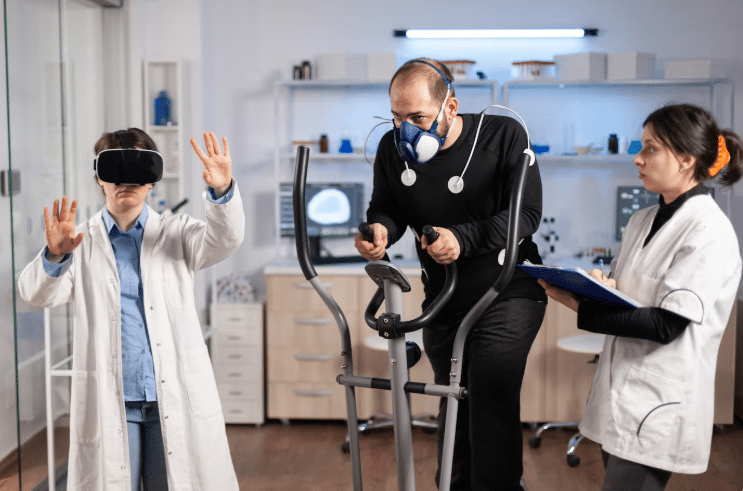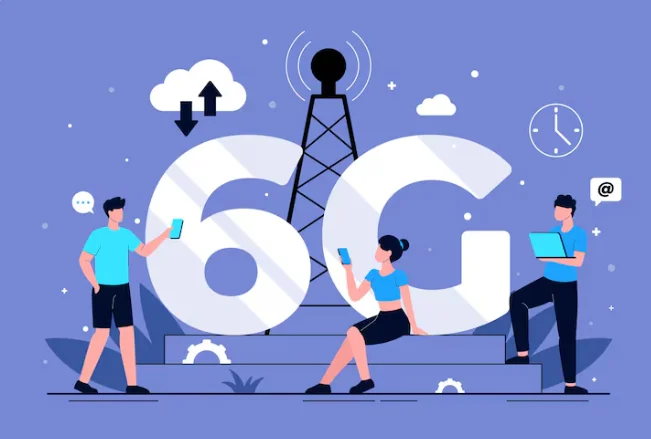
When we think of hospital stays, we often think of fear, discomfort and longing for home, even though hospitals provide easy access to life-saving procedures and dedicated professionals. It’s indeed better to rehabilitate in our own beds at home, near our loved ones.
This desire and medical necessity have conflicted for years. But we are on the cusp of a big shift. With AI, healthcare as an industry is undergoing a massive transformation.
According to Markets and Markets, AI in the healthcare market is projected to reach USD 110.61 billion by 2030 at a staggering CAGR of 38.6%. Evidently, artificial intelligence helps taking quality healthcare to the last mile, ensuring equitable access to all.
The hospital-centric treatment model that has been the norm of modern medicine for many years is slowly shifting to home-centric. Individual and national budget constraints due to the cost explosion are changing the landscape. The increasing prevalence of chronic diseases that require ongoing care rather than quick fixes is a challenge for hospitals built for acute interventions.
The need for alternatives is further highlighted by factors like geographical access restrictions and the psychological and practical costs of hospitalization. Homecare may be the best solution for many areas of health management, the importance of which is felt more after the COVID-19 pandemic.
AI has a big role to play in achieving this goal of taking healthcare to homes. It’s the engine and catalyst that can bring ubiquitous and efficient home-based care. But more than just technical skills are needed to realize this.
Why the Shift is Necessary
Before we get into AI’s potential, we need to recognize the constraints of the system we are coming from. Hospitals are essential for critical treatments and health emergencies but they also have systemic problems.
Hospital stays account for a big chunk of healthcare spending globally so the financial strain is obvious. The indirect costs like transportation costs and patient’s stress have an impact that goes beyond the direct costs.
Accessibility is still a big issue. Accessing a well-equipped hospital might be difficult for people living in underserved urban areas or rural villages which can delay essential medical care. And the hospital paradigm is also reactive.
It does well in emergencies but when it comes to ongoing care like managing chronic conditions, people struggle. As a result, interventions are often delayed because of this reactive approach until the disease has progressed significantly which results in worse outcomes and higher costs.
It also takes a toll on clinicians’ time for proactive planning and individualized care which may be limited by the number of patients they see and staffing demands. So the potential of AI-enabled home healthcare takes care to the people effectively and efficiently.
The Role of AI in Home Healthcare
AI plays a much bigger role than just remote monitoring or telehealth calls. It enables home care. The healthcare industry is on the verge of transformation with AI agents development. It means advanced algorithms automatically analyze complex data, predict risks, customize interventions and coordinate care in ways that were previously unimaginable. Let’s look at a few game-changing use cases:
From Monitoring to Intelligent Anticipation
With technology especially AI, we are moving beyond just observing vital signs of a person’s body.
Wearables that monitor heart rate variability, sleep patterns and activity levels; ambient sensors that detect changes in movement or routine within the home; smart scales and blood pressure cuffs; and even patient-reported symptoms via voice or text interfaces are just a few examples of the continuous data streams that AI is good at integrating and interpreting.
The true power of AI lies in its ability to detect even minute variations that indicate potential problems and understand each person’s unique baseline.
Imagine if an AI system can detect minute changes in breathing patterns overnight, an indication of worsening COPD, weeks before the patient becomes sick, and allow for an early intervention that could even prevent hospitalization. This level of personalization with AI moves us from population averages to truly individual risk assessments.
Democratizing Diagnostics and Triage
AI is making diagnostic services that were previously only available in clinical settings available at home. AI algorithms can evaluate readings of wearable devices like ECG to detect arrhythmias, analyze photos taken on smartphones to diagnose skin disorders or even listen to cough sounds to screen for respiratory infections.
What’s more exciting is that AI can be an intelligent triage system, where we can evaluate the patient’s symptoms and direct them to the best course of action.
Dynamic & Personalized Care Management
To manage chronic illnesses, constant adjustments are needed. AI can suggest truly dynamic treatment plans that are flexible and change instantly. AI can recommend dietary changes or adjust insulin dosages based on data from continuous glucose monitoring in the body.
AI that analyzes mobility data can customize physiotherapy exercises given through an app to a patient recovering from surgery. The ability of AI to anticipate and deal with non-adherence is a key unique feature here.
By identifying trends such as unreported readings or missed medicine reminders, AI can quietly notify a human carer or doctor to check in or trigger tailored, compassionate prompts (perhaps through a conversational AI interface) and improve outcomes.
Bridges Stakeholders
AI is a node that connects all stakeholders in homecare treatment which is a big but least talked about role. A disjointed network including the patient, family carers, home health aides, primary care doctors, specialists and pharmacies is often involved in home-based treatment.
Artificial intelligence services combine data from all these sources to present a unified picture of the patient’s condition. It enables smooth communication through data-backed reports and ensures all parties get the right information at the right time.
The Social Impact Crossroads: Equity or Exacerbated Divides?
AI undoubtedly has huge potential to transform home healthcare but its impact on social equity needs to be watched out. Technology can be biased and reflect the goals and prejudices of the people who created it and the social organizations that use it. AI in home healthcare may further widen existing health gaps if no conscious effort is made to make it more inclusive.
The Promise of Equity
Increased Access
Telehealth and AI-powered remote monitoring can dilute geographical boundaries and bring specialized knowledge and ongoing supervision to isolated areas or remote places often called “medical deserts”.
Breaking Down Barriers
Natural Language Processing (NLP) in AI systems can help with real-time translation or simplification of complex medical information. It can also help people access home healthcare even without health literacy or language barriers.
Assisting Vulnerable Populations
AI-powered healthcare solutions can help elderly people to age in place by providing safety monitoring and connectivity. AI can also empower people with disabilities to take control of their healthcare.
The Peril of Inequity
The Digital Divide
An obvious challenge to AI in home healthcare is people’s access to smartphones, better connectivity and digital literacy. Statistically speaking, the number of smartphone users has increased over time but the quality of internet and ability to use digital tools is necessary for effective AI home health.
This puts constraints on socioeconomically disadvantaged communities who are often on the other side of this gap. What’s needed now is to spread awareness about AI and basic digital literacy at the grassroots level.
Algorithmic Bias
Data is used to train AI models. AI will pick up and reinforce, or even magnify, historical biases in healthcare access for specific racial, ethnic or gender groups. This can result to risk assessments or treatment recommendations for already marginalized communities that are systematically worse. But this can be eliminated with strict bias detection and mitigation techniques.
Security and Privacy
People’s health information is a sensitive thing to handle and poses serious concerns on data privacy. This is more prominent when collecting large volumes of private health information from people’s homes. As a result, HIPAA and other compliances are in place to ensure data security.
Who owns this data? To what extent is it sent and stored securely? Are patients providing informed consent especially those who are in precarious situations?
The solution lies in having a comprehensive law and framework on how data should be used, who should be held accountable, what safety measures should be taken etc.
The Risk of Depersonalization
Relying too much on technology at the expense of human interaction may undermine empathy and trust which are essential for healing. This is true especially for those who may already feel abandoned and alone.
A better way forward is to use digital technology rationally or even better, couple technology with human expertise.
We must address these challenges head on if we want to achieve equitable results. Equity must be a design element and a success factor for AI in home healthcare.
The Human Touch in an AI-Powered World
The idea that AI will replace human interaction in healthcare is a common concern. This however shows a misinterpretation of AI’s role. Augmentation not replacement should be the goal. AI can take away healthcare professionals from time-consuming administrative tasks many of which are mundane and routine. With digital transformation happening rapidly, AI is making the world a better place.
By partnering with a trusted AI development company, various routine processes can be automated. This gives them the time and skills to focus on what people do best, some of which include clinical reasoning, building trust-based relationships, communicating empathetically etc.
By giving them clearer insights and actionable alerts, AI can empower family carers and home health aides to provide better, more informed support and maybe reduce carer’s burnout. To use and understand AI-driven tools effectively, these people will also need training and support.
While humans provide the context, empathy and critical decision making, AI can provide the constant watchfulness and analytical capability. Balancing this is key to building trust and ensuring patient welfare.

The Hidden Business Power of Storytelling Through Books

Diamond Painting Apps & Digital Tools for 2025 Artists

Meeting Global Tastes: The Versatility of Commercial Tortilla Makers

Accelerating drug discovery through the DEL-ML-CS approach

AI in Marketing Is No Longer a Buzzword — It’s the Strategy

The Full Guide To Penetration Testing

Pixel 10 Pro Fold Case: Why Choose Aramid Fiber?

MT4 for Mac vs Windows: Which Version Works Better for Traders








